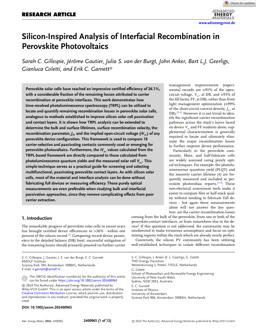2024-07-09
Silicon-Inspired Analysis of Interfacial Recombination in Perovskite Photovoltaics
Publication
Publication
Adv. Energy Mater. , Volume 14 - Issue 35 p. 2400965: 1- 12
Perovskite solar cells have reached an impressive certified efficiency of 26.1%, with a considerable fraction of the remaining losses attributed to carrier recombination at perovskite interfaces. This work demonstrates how time-resolved photoluminescence spectroscopy (TRPL) can be utilized to locate and quantify remaining recombination losses in perovskite solar cells, analogous to methods established to improve silicon solar cell passivation and contact layers. It is shown how TRPL analysis can be extended to determine the bulk and surface lifetimes, surface recombination velocity, the recombination parameter, J0, and the implied open-circuit voltage (iVoc) of any perovskite device configuration. This framework is used to compare 18 carrier-selective and passivating contacts commonly used or emerging for perovskite photovoltaics. Furthermore, the iVoc values calculated from the TRPL-based framework are directly compared to those calculated from photoluminescence quantum yields and the measured solar cell Voc. This simple technique serves as a practical guide for screening and selecting multifunctional, passivating perovskite contact layers. As with silicon solar cells, most of the material and interface analysis can be done without fabricating full devices or measuring efficiency. These purely optical measurements are even preferable when studying bulk and interfacial passivation approaches, since they remove complicating effects from poor carrier extraction.
| Additional Metadata | |
|---|---|
| , , , | |
| Wiley-VCH | |
| doi.org/10.1002/aenm.202400965 | |
| Adv. Energy Mater. | |
| Organisation | Nanoscale Solar Cells |
|
Gillespie, S., Gautier, J., van der Burgt, J., Anker, J., Geerlings, B., Coletti, G., & Garnett, E. (2024). Silicon-Inspired Analysis of Interfacial Recombination in Perovskite Photovoltaics. Adv. Energy Mater., 14(35), 2400965: 1–12. doi:10.1002/aenm.202400965 |
|
